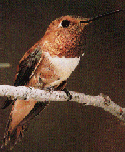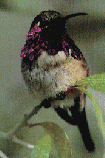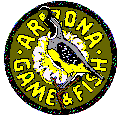Jewels
of the Bird World!

Hummingbirds are fascinating, to an extent far
disproportionate to their size. Darting from flower to flower, sunlight
flashing on their brightly colored throats and crowns, hummingbirds are widely
known as the jewels of the bird world. It's hard to believe, but very true: all
that dazzling color is produced by feather structure, and not by pigment.
More than 340 species of hummingbirds are known today, but all of them
occur only in the Americas. It is Arizona's good fortune to have had recorded
within its boundaries 16 species, more than any other state. In fact, of all
the species regularly found in the United States, only two, the buff-bellied
and ruby-throated, have not been recorded in Arizona. At least, not yet!
Attracting hummingbirds is easy almost anywhere in Arizona. Just landscape
your yard with brightly flowering shrubs, trees and wildflowers. Among the many
southwestern plants with the tubular flowers that attract hummingbirds are
penstemon, paintbrush, ocotillo, honeysuckle, chuparosa, coral bean, gilia,
cardinal flower, sage, columbine and bouvardia. Aside from bright colors, these
flowers all have one thing in common: they produce a 20 to 30 percent sucrose
solution. Plants such as ocotillo, mesquite and desert willow offer twice the
benefit, because they also provide nest sites for hummers. A little creative
landscaping with some of these low-maintenance plants is all that is needed,
but a "nectar" feeder (or several!) will add immeasurable to your fun by
attracting even more hummers, as well as other native birds, such as orioles
and house finches.
Selecting a feeder
There are probably as many kinds of hummingbird feeders as there
are hummingbirds, and almost any feeder will do, whether it is made of plastic,
glass or ceramic. Even so, some are better than others, because they are easier
to clean, spill less easily, or discourage bees and wasps. Remember, though, a
feeder that bees and wasps can't use will probably not be accessible to orioles
and house finches, either. So why not use several kinds, and enjoy watching
these other birds, too?
Regardless of which type you use, place the
feeder out of direct sunlight and fairly close to shrubs or trees, so visiting
hummers can perch nearby. Besides offering a rest stop, such perches offer
hummers a convenient location from which to watch "their" feeder, and protect
it from intruders. These pugnacious little warriors will make lightning-like
attacks on their competitors at the drop of a hat, and the extended
fight-chases are a sight to be seen.
There is only one solution
Regardless of the type of feeder or the species attracted, the
solution should always be four to five cups of water to one cup of cane or
table sugar (it's sucrose, just like flowers produce). Never use sugar
substitutes, and honey spoils quickly and grows fungus that may be
lethal to hummers. There is no need to use dye in the solution. Red plastic,
paint or tape on the feeder is just as effective.
Preparing the
solution is simple. For the best results, boil the water, add the sugar and let
the mix cool. Fill the feeder with only as much solution as will be used in a
day. This causes a bit more work for you, but will assure the hummers a fresh
food supply. Extra mix can be kept refrigerated for a week or two, while it is
used for daily refills.
Maintenance is important
Feeders should always be kept at least partially filled and very
clean, or else they should be taken down. Clean your feeders at least every
five to seven days, using baby-bottle brushes or pipe cleaners and hot water. A
small dose of vinegar will help remove any mold, but rinse the feeder very well
afterward! And never use detergent or soap.
Finally, don't worry about
taking your feeder down in the winter. Just be extra sure to keep it filled.
The hummers will leave if the weather turns cold. Not even a full feeder will
keep them from heading south if they want to leave.
A few facts
 It takes a fantastic amount of energy for hummingbirds to keep
their wings beating, at 40 or more beats per second. Ounce for ounce, their
metabolic rate is about 300 times that of a human! Their natural diet includes
tiny insects, spiders and other invertebrates, as well as flower nectar. That's
why injured and orphaned hummingbirds that are rehabilitated for release to the
wild through the Department's Adobe Mountain Wildlife Center, in Phoenix, are
fed a special three-phase commercially prepared high-protein diet that is more
nutritionally complete than sugar water. It takes a fantastic amount of energy for hummingbirds to keep
their wings beating, at 40 or more beats per second. Ounce for ounce, their
metabolic rate is about 300 times that of a human! Their natural diet includes
tiny insects, spiders and other invertebrates, as well as flower nectar. That's
why injured and orphaned hummingbirds that are rehabilitated for release to the
wild through the Department's Adobe Mountain Wildlife Center, in Phoenix, are
fed a special three-phase commercially prepared high-protein diet that is more
nutritionally complete than sugar water.
Landscaping with desert
plants and avoiding the use of insecticides will help give the hummingbirds in
your area a balanced diet. Add a feeder or two and you will enjoy countless
hours of fast-action birdwatching, even in the winter. Anna's hummingbird nests
in Arizona in the winter, and a few individuals of other species also linger
here occasionally, whether or not feeders are available.
Problem Solving
Uh oh: ants and bees, the bane of picnics and hummingbird feeders.
To keep ants away, spread liberal amounts of petroleum jelly or mineral oil on
the wire from which your feeder hangs. Double-sided sticky tape wrapped around
the wire also works pretty well. As for bees, just spread a little petroleum
jelly around the feeder openings. The odor of the petroleum jelly will not
bother any birds, since most species (including all hummingbirds) have a very
poorly developed sense of smell.
There is also a gentler, kinder
approach. Accept the ants and bees as a natural consequence of feeding hummers.
Or plant a garden with non-hummingbird flowers to distract the bees.
 Written by: Terry B. Johnson, Manager, Nongame & Endangered
Wildlife Program, Arizona Game and Fish Department. Written by: Terry B. Johnson, Manager, Nongame & Endangered
Wildlife Program, Arizona Game and Fish Department.
For more information
about this project or to make a donation, write: Nongame and Endangered
Wildlife Program, Arizona Game and Fish Department, 2221 West
Greenway Road, Phoenix, Arizona 85023-4312
Published with permission of
Suzanne Trachy, Information and Education Coordinator, Arizona Game and Fish
Department, Region 1, HC 62 Box 7201, Pinetop, Arizona
|

